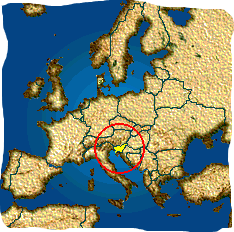Political system : democratic republic
Location : Central Europe
Capital city : Ljubljana
Population : approximately 2 million
Nationality : Slovenian
Total area : 20,273 km²Land: 20,151 km²
Water surfaces: 122 km² (+ ~180 km² Adriatic Sea)
Forest coverage : ~58%Highest point : Triglav - 2,864 mLowest point : Adriatic Sea - 0 m (-32 m)Coastline length : 43,157 mLongest river : Sava - 221 km in SloveniaLargest natural lake : Lake Bohinj - 3.18 km²Precipitation : 800-3,500 mm/yearAnnual temperature : from 0°C (Kredarica) to 13°C (Portorož)The average annual temperature in Slovenia ranges from approximately 0°C in the high mountains to 13°C- along the coast , with a national average around 9°C-10°C . In recent decades, it has noticeably increased due to climate change.
Slovenia in the European context
Physical Geography of Slovenia
Slovenia lies in a geologically and geomorphologically highly diverse area, where four major European natural units converge: the Alps , Dinaric Mountains , Pannonian Plain , and Adriatic Coastal Region . This location creates high landscape diversity, ecological richness, and complex climatic dynamics.
Relief units
Alpine region (28°-): Julian Alps, Kamnik-Savinja Alps, Karawanks. Peaks above 2,000 m, glacial valleys, cirques, moraines. Highest peak: Triglav (2,864 m).Dinaric Karst (23°-): karst plateaus, poljes (Cerknica, Planina), sinking rivers, caves (Postojna, Škocjan - UNESCO).Pannonian region (22°-): plains and hills along the Mura, Drava, Krka; sedimentary basins, thermal springs.Coastal region (2°-): Slovenian Istria, cliffs, salt pans, karst edge; Adriatic coastline length: 43,157 m.
Geological structure
Lithological zones : limestone and dolomite (karst), metamorphic rocks (Alps), Neogene sediments (Pannonian Plain).Tectonics : junction of the Eurasian and Adriatic microplates; main faults: Idrija, Sava, Labot. Seismic risk: moderate to high.Mineral heritage : Idrija - mercury mine (largest in Europe); mining areas in Mežica, Litija.
Climate
Climate zones : alpine (>1,500 m), continental (interior), sub-Mediterranean (Primorska).Precipitation : from 800 mm (Prekmurje) to 3,500 mm (Julian Alps); highest values in the west.Temperatures : average annual temperature: Ljubljana ~10°, Kredarica ~0°, Portorož ~13°.Winds : bora (Vipava Valley), foehn (Alps), sirocco (coast), valley winds.
Hydrological system
Watersheds : 81°- of the territory drains into the Danube (Sava , Drava, Mura), 19°- into the Adriatic (Soča , Vipava ).Rivers : Sava (221 km), Drava (142 km), Mura (95 km), Soča (138 km), Krka (94 km).Lakes : Lake Bled (glacial), Lake Bohinj (largest natural), Lake Cerknica (intermittent), Lake Velenje (artificial).Groundwater : karst aquifers, thermal springs (Rogaška Slatina, Radenci, Čatež).Wetlands : Ljubljana Marshes , Škocjanski zatok , Mura floodplains .
Soils
Rendzinas : on limestone and dolomite (karst).Brown forest soils : on silicate rocks (Alps, mid-altitudes).Fluvisols : along rivers (Sava, Drava, Mura).Peat soils : Ljubljana Marshes
Vegetation and biogeography
Forests : cover ~58°- of the territory; dominated by beech, spruce, mixed forests.Alpine flora : dwarf pine, alpine grasses, endemics (Triglav rose).Sub-Mediterranean vegetation : maquis, holm oak, olive, laurel.Biogeographic regions : alpine, continental, Mediterranean - high species diversity.
Protected areas


 virtual excursions 360°
virtual excursions 360°
